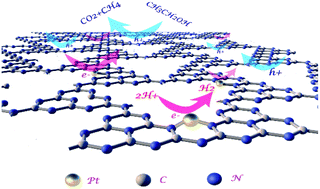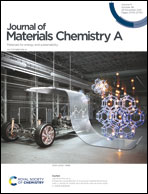H2 and CH4 production from bio-alcohols using condensed poly(heptazine imide) with visible light†
Abstract
Photocatalytic H2 production via water splitting holds great potential for the conversion of solar energy into renewable and storable chemical fuels in a sustainable manner, but this up-hill reaction is mainly hindered by the water oxidation process. This reaction is sluggish and relies on high overpotentials (wasted energy), while only oxygen is generated as a low value oxidation by-product. Coupling hydrogen generation to a less unfavorable oxidation reaction creating higher value products is therefore a recommendable issue. Here we found that poly(heptazine imide) (PHI), a stable and reactive allotrope of crystalline carbon nitride, supported with highly dispersed Pt nanoparticles (PtNPs) could achieve efficient and persistent H2 and CH4 production by photocatalytic reforming of biomass derived alcohols under visible light irradiation. The results reveal that PHI with low grain boundary defects restrains the bulk charge carrier recombination and largely promotes photocatalytic efficiency. The apparent quantum efficiency (AQE) of the optimized material for visible light H2 evolution could reach values as high as 15% at 420 nm. The DFT results reveal that the activity is associated with the Tafel step rather than the Volmer–Tafel step. This study highlights the development of a new covalent scaffold for the simultaneous generation of storable and valuable chemical fuels (H2 and CH4) in a feasible photocatalytic manner.

- This article is part of the themed collection: Journal of Materials Chemistry A HOT Papers


 Please wait while we load your content...
Please wait while we load your content...